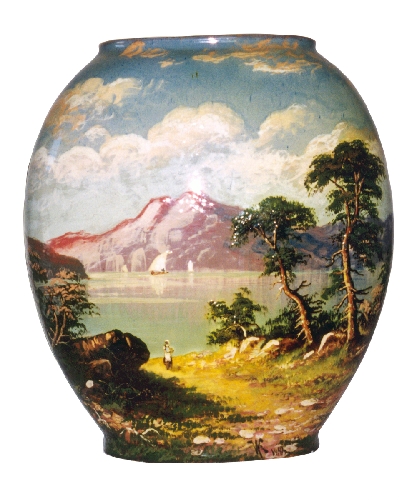Exhibition prompts start of art pottery

Art pottery was first made in the United States by a group of women in Cincinnati who had seen the pottery exhibits at the Centennial Exhibition in Philadelphia in 1876. Several groups were making pottery by the 1880s.
A pottery was started in 1883 by two men: Matt Morgan, an English political cartoonist, and George Ligowsky, the inventor of the clay pigeon for target shooters. The Matt Morgan Art Pottery Co. of Cincinnati made pieces inspired by Moorish designs and colors. Some of its other wares resembled Rookwood pottery, possibly because some artists worked at both potteries.
Matt Morgan Pottery closed in 1884. Matt Morgan pieces are hard to find today, even though almost all are clearly marked with the name of the firm. Important pieces sell for more than $1,000.
Q: I bought a wooden night table at an auction years ago. Its a 1950s style, but the finish is reddish brown, not blond. The single drawer in the stand is marked Heywood-Wakefield within a circle. Also in the circle mark are the initials HW and an eagles head. Below the circle, the mark reads, Est. 1826. How old is the night table, and what is it worth?
A: Heywood-Wakefield Co. of Gardner, Mass., traces its history back to 1826, but it didnt start using the name Heywood-Wakefield until 1921, and it began using the eagle trademark in 1946. So your nightstand dates from the late 1940s or early 50s.
Not all Heywood-Wakefield furniture was blond. The company offered other finishes, including one called amber.
If your nightstand is in excellent shape with its original finish, it could sell for a few hundred dollars. Heywood-Wakefield closed in 1979, but the brand and designs were resurrected in 1992 by South Beach Furniture Co. of Miami Beach.
Q: I have an 11½-inch Barbie-type doll that actually gets a tan if shes in sunlight. Her hair color is reversible from blond to brunette. I cant find any information on it. Can you help?
A: Your doll was made by Ideal and is not one of the Barbie dolls, which were made by Mattel.
Ideal made three different dolls that tanned when exposed to the sun. Suntan Tuesday is 11½ inches tall and has hair that swivels to change from blond to brunette. Her boyfriend, Suntan Eric, is 12 inches, and her little sister, Suntan Dodi, is 9 inches. The dolls came with stickers that could be put on the dolls before tanning and then removed to reveal the lighter skin under the sticker. They were made for Ideal in Hong Kong in 1977 and 1978.
Your Suntan Tuesday doll is worth about $40 to $70 with its original box.
Q: I just inherited a collection of Bakelite jewelry. How can I tell which pieces are valuable?
A: Condition, rarity and design determine value. Condition is easiest to figure out. Examine each piece for cracks; discolored or missing hinges, pins, chains, etc.; and repairs, especially glue.
Its a little more difficult to learn to recognize good and bad colors. Bakelite gradually changes color through the years. Colors should be in the yellow-orange, red-cream or muddy-green shades. You should never find blue or clear old Bakelite.
Look for unexpected holes on the back of pins; they originally may have been buttons. See if any carving looks hand-done. Watch out for altered pieces, like bangle bracelets that have been given new polka dots.
Visit shops and online sites that sell Bakelite jewelry and read books on the subject. You will soon learn what is rare and expensive.
Q: I keep an old tin toy truck stored away in an old Sharps toffee tin. I was going to ask you a question about my truck, but Ive become more interested in the toffee tin. Its a cylinder covered in paper painted to look like a dandy. Hes wearing a monocle and carrying a cane. The round tin top is shaped like a hat with a brim. Its marked The Happynak Series, British Made. How old is it, and is it worth saving?
A: Edward Sharp & Sons was founded in Maidstone, Kent, England, in 1911. Its Sharps Kreemy Toffee was sold in all sorts of decorative tins until the company closed in 1999, when it became part of Cadbury.
Your tin is an early one, perhaps made as early as 1930. Old figural tins are collectible and, in good condition, sell for $50 to $150. Prices are even higher for more popular brands. Keep it away from sticky hands and bright light.
Q: I have an upright cedar chest that was in my grandparents house for many years. Inside the lid, it is marked West Branch Novelty Company, Milton, Pa. I think its mahogany. Can you tell me anything about it?
A: West Branch Novelty Co. was founded in 1893 in Milton. The company started out making bamboo furniture, but by the early 1900s, cedar chests were its most important product.
The company made boxes for shrapnel shells during World War I. Furniture production was resumed after the end of the war. The company is no longer in business.
Many different styles of cedar chests were made. Some sell for $50 to $100 or more, depending on size and condition.
Tip: Cover the nose of your hammer with a piece of felt to protect the wall when you are putting up picture hooks. If the wall is smooth, some of the new stick-on hooks might work.
Terry Kovels column is syndicated by King Features. Write to: Kovels, (Las Vegas Review-Journal), King Features Syndicate, 300 W. 57th St., New York, NY 10019.